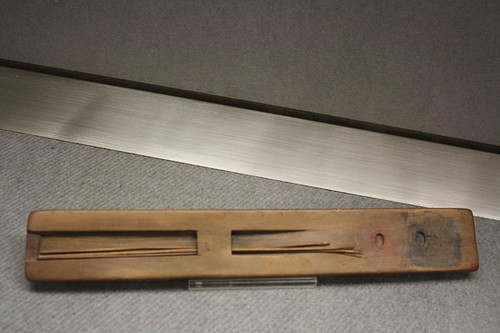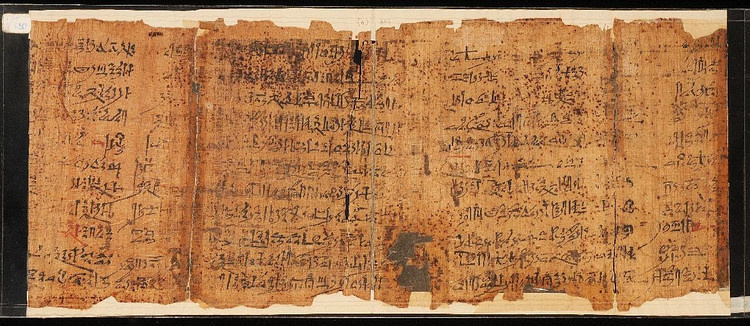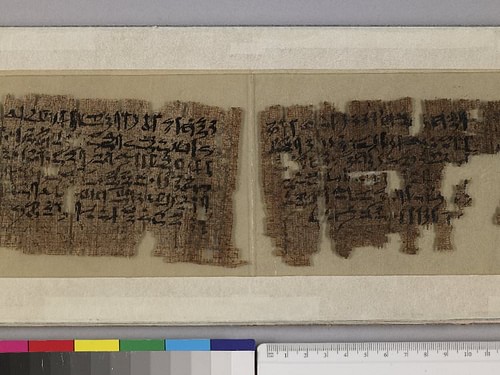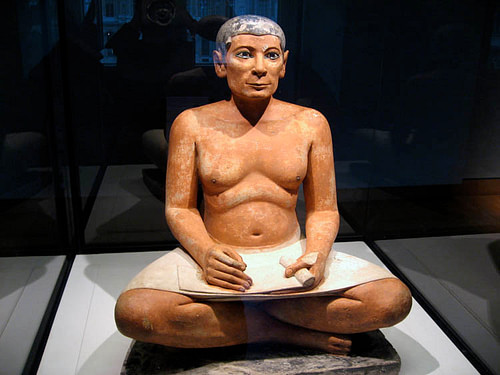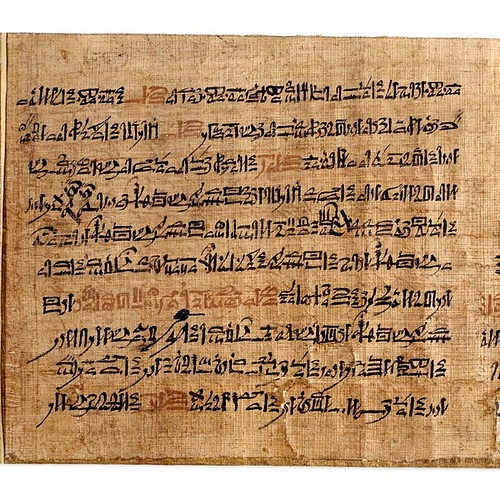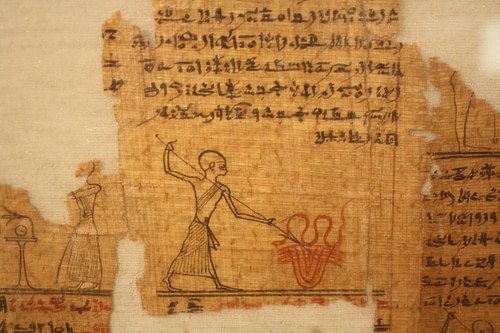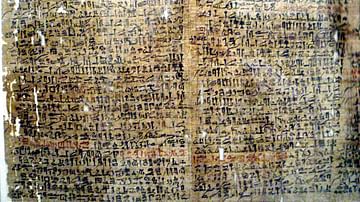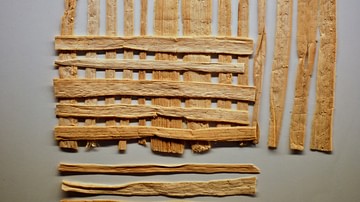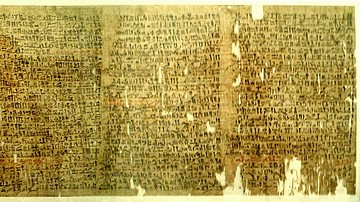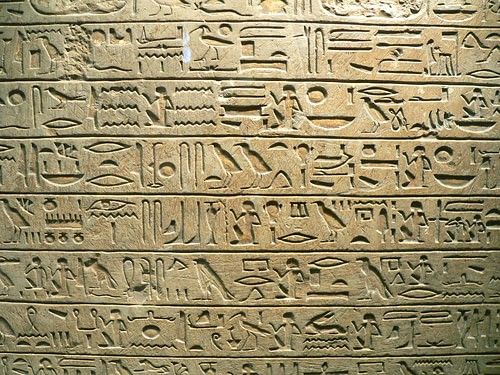
Ancient Egyptian literature comprises a wide array of narrative and poetic forms including inscriptions on tombs, stele, obelisks, and temples; myths, stories, and legends; religious writings; philosophical works; wisdom literature; autobiographies; biographies; histories; poetry; hymns; personal essays; letters and court records.
Although many of these forms are not usually defined as "literature" they are given that designation in Egyptian studies because so many of them, especially from the Middle Kingdom (2040-1782 BCE), are of such high literary merit. The first examples of Egyptian writing come from the Early Dynastic Period (c. 6000- c. 3150 BCE) in the form of Offering Lists and autobiographies; the autobiography was carved on one's tomb along with the Offering List to let the living know what gifts, and in what quantity, the deceased was due regularly in visiting the grave.
Since the dead were thought to live on after their bodies had failed, regular offerings at graves were an important consideration; the dead still had to eat and drink even if they no longer held a physical form. From the Offering List came the Prayer for Offerings, a standard literary work which would replace the Offering List, and from the autobiographies grew the Pyramid Texts which were accounts of a king's reign and his successful journey to the afterlife; both these developments took place during the period of the Old Kingdom (c. 2613-c.2181 BCE).
These texts were written in hieroglyphics ("sacred carvings") a writing system combining phonograms (symbols which represent sound), logograms (symbols representing words), and ideograms (symbols which represent meaning or sense). Hieroglyphic writing was extremely labor intensive and so another script grew up beside it known as hieratic ("sacred writings") which was faster to work with and easier to use.
Hieratic was based on hieroglyphic script and relied on the same principles but was less formal and precise. Hieroglyphic script was written with particular care for the aesthetic beauty of the arrangement of the symbols; hieratic script was used to relay information quickly and easily. In c. 700 BCE hieratic was replaced by demotic script ("popular writing") which continued in use until the rise of Christianity in Egypt and the adoption of Coptic script c. 4th century CE.
Most of Egyptian literature was written in hieroglyphics or hieratic script; hieroglyphics were used on monuments such as tombs, obelisks, stele, and temples while hieratic script was used in writing on papyrus scrolls and ceramic pots. Although hieratic, and later demotic and Coptic, scripts became the common writing system of the educated and literate, hieroglyphics remained in use throughout Egypt's history for monumental structures until it was forgotten during the early Christian period.
Although the definition of "Egyptian Literature" includes many different types of writing, for the present purposes attention will mostly be paid to standard literary works such as stories, legends, myths, and personal essays; other kinds or work will be mentioned when they are particularly significant. Egyptian history, and so literature, spans centuries and fills volumes of books; a single article cannot hope to treat of the subject fairly in attempting to cover the wide range of written works of the culture.
Literature in the Old Kingdom
The Offering Lists and autobiographies, though not considered "literature", are the first examples of the Egyptian writing system in action. The Offering List was a simple instruction, known to the Egyptians as the hetep-di-nesw ("a boon given by the king"), inscribed on a tomb detailing food, drink, and other offerings appropriate for the person buried there. The autobiography, written after the person's death, was always inscribed in the first person as though the deceased were speaking. Egyptologist Miriam Lichtheim writes:
The basic aim of the autobiography - the self-portrait in words - was the same as that of the self-portrait in sculpture and relief: to sum up the characteristic features of the individual person in terms of his positive worth and in the face of eternity. (4)
These early obituaries came to be augmented by a type of formulaic writing now known as the Catalogue of Virtues which grew from "the new ability to capture the formless experiences of life in the enduring formulations of the written word" (Lichtheim, 5). The Catalogue of Virtues accentuated the good a person had done in his or her life and how worthy they were of remembrance. Lichtheim notes that the importance of the Virtues was that they "reflected the ethical standards of society" while at the same time making clear that the deceased had adhered to those standards (5). Some of these autobiographies and lists of virtues were brief, inscribed on a false door or around the lintels; others, such as the well-known Autobiography of Weni, were inscribed on large monolithic slabs and were quite detailed. The autobiography was written in prose; the Catalogue in formulaic poetry. A typical example of this is seen in the Inscription of Nefer-Seshem-Ra Called Sheshi from the 6th Dynasty of the Old Kingdom:
I have come from my town
I have descended from my nome
I have done justice for its lord
I have satisfied him with what he loves.
I spoke truly, I did right
I spoke fairly, I repeated fairly
I seized the right moment
So as to stand well with people.
I judged between two so as to content them
I rescued the weak from the stronger than he
As much as was in my power.
I gave bread to the hungry, clothes to the naked
I brought the boatless to land.
I buried him who had no son,
I made a boat for him who lacked one.
I respected my father, I pleased my mother,
I raised their children.
So says he whose nickname is Sheshi. (Lichtheim, 17)
These autobiographies and virtue lists gave rise to the Pyramid Texts of the 5th and 6th dynasties which were reserved for royalty and told the story of a king's life, his virtues, and his journey to the afterlife; they therefore tried to encompass the earthly life of the deceased and his immortal journey on into the land of the gods and, in doing so, recorded early religious beliefs. Creation myths such as the famous story of Atum standing on the primordial mound amidst the swirling waters of chaos, weaving creation from nothing, comes from the Pyramid Texts. These inscriptions also include allusions to the story of Osiris, his murder by his brother Set, his resurrection from the dead by his sister-wife Isis, and her care for their son Horus in the marshes of the Delta.
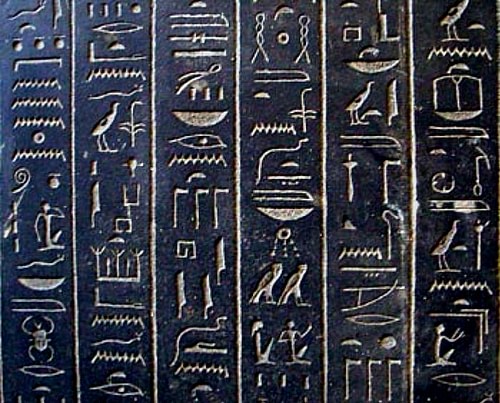
Following closely on the heels of the Pyramid Texts, a body of literature known as the Instructions in Wisdom appeared. These works offer short maxims on how to live much along the lines of the biblical Book of Proverbs and, in many instances, anticipate the same kinds of advice one finds in Proverbs, Ecclesiastes, Psalms, and other biblical narratives. The oldest Instruction is that of Prince Hardjedef written sometime in the 5th Dynasty which includes advice such as:
Cleanse yourself before your own eyes
Lest another cleanse you.
When you prosper, found your household,
Take a hearty wife, a son will be born to you.
It is for the son you build a house
When you make a place for yourself. (Lichtheim, 58)
The somewhat later Instruction Addressed to Kagemni advises:
The respectful man prospers,
Praised is the modest one.
The tent is open to the silent,
The seat of the quiet is spacious
Do not chatter!...
When you sit with company,
Shun the food you love;
Restraint is a brief moment
Gluttony is base and is reproved.
A cup of water quenches the thirst,
A mouthful of herbs strengthens the heart. (Lichtheim, 59-60)
There were a number of such texts, all written according to the model of Mesopotamian Naru Literature, in which the work is ascribed to, or prominently features, a famous figure. The actual Prince Hardjedef did not write his Instruction nor was Kagemni's addressed to the actual Kagemni. As in Naru literature, a well-known person was chosen to give the material more weight and so wider acceptance. Wisdom Literature, the Pyramid Texts, and the autobiographical inscriptions developed significantly during the Old Kingdom and became the foundation for the literature of the Middle Kingdom.
Middle Kingdom Literature
The Middle Kingdom is considered the classical age of Egyptian literature. During this time the script known as Middle Egyptian was created, considered the highest form of hieroglyphics and the one most often seen on monuments and other artifacts in museums in the present day. Egyptologist Rosalie David comments on this period:
The literature of this era reflected the added depth and maturity that the country now gained as a result of the civil wars and upheavals of the First Intermediate Period. New genres of literature were developed including the so-called Pessimistic Literature, which perhaps best exemplifies the self-analysis and doubts that the Egyptians now experienced. (209)
The Pessimistic Literature David mentions is some of the greatest work of the Middle Kingdom in that it not only expresses a depth of understanding of the complexities of life but does so in high prose. Some of the best known works of this genre (generally known as Didactic Literature because it teaches some lesson) are The Dispute Between a Man and his Ba (soul), The Eloquent Peasant, The Satire of the Trades, The Instruction of King Amenemhet I for his Son Senusret I, the Prophecies of Neferti, and the Admonitions of Ipuwer.
The Dispute Between a Man and his Ba is considered the oldest text on suicide in the world. The piece presents a conversation between a narrator and his soul on the difficulties of life and how one is supposed to live in it. In passages reminiscent of Ecclesiastes or the biblical Book of Lamentations, the soul tries to console the man by reminding him of the good things in life, the goodness of the gods, and how he should enjoy life while he can because he will be dead soon enough. Egyptologist W.K. Simpson has translated the text as The Man Who Was Weary of Life and disagrees with the interpretation that it has to do with suicide. Simpson writes:
This Middle Kingdom text, preserved on Papyrus Berlin 3024, has often been interpreted as a debate between a man and his ba on the subject of suicide. I offer here the suggestion that the text is of a somewhat different nature. What is presented in this text is not a debate but a psychological picture of a man depressed by the evil of life to the point of feeling unable to arrive at any acceptance of the innate goodness of existence. His inner self is, as it were, unable to be integrated and at peace. (178)
The depth of the conversation between the man and his soul, the range of life experiences touched on, is also seen in the other works mentioned. In The Eloquent Peasant a poor man who can speak well is robbed by a wealthy landowner and presents his case to the mayor of the town. The mayor is so impressed with his speaking ability that he keeps refusing him justice so he can hear him speak further. Although in the end the peasant receives his due, the piece illustrates the injustice of having to humor and entertain those in positions of authority in order to receive what they should give freely.
The Satire of the Trades is presented as a man advising his son to become a scribe because life is hard and the best life possible is one where a man can sit around all day doing nothing but writing. All the other trades one could practice are presented as endless toil and suffering in a life which is too short and precious to waste on them.
The motif of the father advising his son on the best course in life is used in a number of other works. The Instruction of Amenemhat features the ghost of the assassinated king warning his son not to trust those close to him because people are not always what they seem to be; the best course is to keep one's own counsel and be wary of everyone else. Amenemhat's ghost tells the story of how he was murdered by those close to him because he made the mistake of believing the gods would reward him for a virtuous life by surrounding him with those he could trust. In Shakespeare's Hamlet Polonius advises his son, "Those friends thou hast, and their adoption tried/ Grapple them unto thy soul with hoops of steel/ But do not dull thy palm with entertainment of each new-hatched, unfledged courage" (I.iii.62-65). Polonius here is telling his son not to waste time on those he barely knows but to trust only those who have proven worthy. Amenemhat I's ghost makes it clear that even this is a foolish course:
Put no trust in a brother,
Acknowledge no one as a friend,
Do not raise up for yourself intimate companions,
For nothing is to be gained from them.
When you lie down at night, let your own heart be watchful over you,
For no man has any to defend him on the day of anguish. (Simpson, 168)
The actual king Amenemhat I (c. 1991-1962 BCE) was the first great king of the 12th Dynasty and was, in fact, assassinated by those close to him. The Instruction bearing his name was written later by an unknown scribe, probably at the request of Senusret I (c. 1971-1926 BCE) to eulogize his father and vilify the conspirators. Amenemhat I is further praised in the work Prophecies of Neferti which foretell the coming of a king (Amenemhat I) who will be a savior to the people, solve all the country's problems, and inaugurate a golden age. The work was written after Amenemhat I's death but presented as though it were an actual prophecy pre-dating his reign.
This motif of the "false prophecy" - a vision recorded after the event it supposedly predicts - is another element found in Mesopotamian Naru literature where the historical "facts" are reinterpreted to suit the purposes of the writer. In the case of the Prophecies of Neferti, the focus of the piece is on how mighty a king Amenemhat I was and so the vision of his reign is placed further back in time to show how he was chosen by the gods to fulfil this destiny and save his country. The piece also follows a common motif of Middle Kingdom literature in contrasting the time of prosperity of Amenemhat I's reign, a "golden age", with a previous one of disunity and chaos.
The Admonitions of Ipuwer touches on this theme of a golden age more completely. Once considered historical reportage, the piece has come to be recognized as literature of the order vs. chaos didactic genre in which a present time of despair and uncertainty is contrasted with an earlier era when all was good and life was easy. The Admonitions of Ipuwer is often cited by those wishing to align biblical narratives with Egyptian history as proof of the Ten Plagues from the Book of Exodus but it is no such thing.
Not only does it not - in any way - correlate to the biblical plagues but it is quite obviously a type of literary piece which many, many cultures have produced throughout history up to the present day. It is hardly an exaggeration to say that everyone, at some point in his or her life, has looked back on the past and compared it favorably to the present. The Admonitions of Ipuwer simply records that experience, though perhaps more eloquently than most, and can in no way be interpreted as an actual historical account.
In addition to these prose pieces, the Middle Kingdom also produced the poetry known as The Lay of the Harper (also known as The Songs of the Harper), which frequently question the existence of an ideal afterlife and the mercy of the gods and, at the same time, created hymns to those gods affirming such an afterlife. The most famous prose narratives in Egyptian history - The Tale of the Shipwrecked Sailor and The Story of Sinuhe both come from the Middle Kingdom as well. The Tale of the Shipwrecked Sailor holds Egypt up as the best of all possible worlds through the narrative of a man shipwrecked on an island and offered all manner of wealth and happiness; he refuses, however, because he knows that all he wants is back in Egypt. Sinuhe's story reflects the same ideal as a man is driven into exile following the assassination of Amenemhat I and longs to return home.
The complexities Egypt had experienced during the First Intermediate Period (2181-2040 BCE) were reflected in the literature which followed in the Middle Period. Contrary to the claim still appearing in history books on Egypt, the First Intermediate Period had not been a time of chaos, darkness, and universal distress; it was simply a time when there was no strong central government. This situation resulted in a democritization of art and culture as individual regions developed their own styles which were valued as greatly as royal art had been in the Old Kingdom.
The Middle Kingdom scribes, however, looked back on the time of the First Intermediate Period and saw in it a clear departure from the glory of the Old Kingdom. Works such as The Admonitions of Ipuwer were interpreted by later Egyptologists as accurate accounts of the chaos and disorder of the era preceding the Middle Kingdom but actually, if it were not for the freedom of exploration and expression in the arts the First Intermediate Period encouraged, the later scribes could never have written the works they produced.
The royal autobiographies and Offering Lists of the Old Kingdom, only available to kings and nobles, were made use of in the First Intermediate Period by anyone who could afford to build a tomb, royal and non-royal alike. In this same way, the literature of the Middle Kingdom presented stories which could praise a king like Amenemhat I or present the thoughts and feelings of a common sailor or the nameless narrator in conflict with his soul. The literature of the Middle Kingdom opened wide the range of expression by enlarging upon the subjects one could write about and this would not have been possible without the First Intermediate Period.
Following the age of the 12th Dynasty, in which the majority of the great works were created, the weaker 13th Dynasty ruled Egypt. The Middle Kingdom declined during this dynasty in all aspects, finally to the point of allowing a foreign people to gain power in lower Egypt: The Hyksos and their period of control, just like the First Intermediate Period, would be vilified by later Egyptian scribes who would again write of a time of chaos and darkness. In reality, however, the Hyksos would provide valuable contributions to Egyptian culture even though these were ignored in the later literature of the New Kingdom.
Literature in the New Kingdom
Between the Middle Kingdom and the era known as the New Kingdom falls the time scholars refer to as the Second Intermediate Period (c. 1782-c.1570 BCE). During this era rule in Egypt was divided between the foreign kings of the Hyksos in Lower Egypt at Avaris, Egyptian rule from Thebes in Upper Egypt, and control of the southern reaches of Upper Egypt by the Nubians. Egypt was united, and the Hyksos and Nubians driven beyond the borders, by Ahmose of Thebes (c. 1570-1544 BCE) who inaugurated the New Kingdom. The memory of the Hyksos "invasion" remained fresh in the minds of the Egyptians and was reflected in the political policies and the literature of the period.
The early pharaohs of the New Kingdom dedicated themselves to preventing any kind of incursion like that of the Hyksos and so embarked on a series of military campaigns to expand Egypt's borders; this resulted in the Age of Empire for Egypt which was reflected in a broader scope of content in the literature and art. Monumental inscriptions of the gods of Egypt and their enduring support for the pharaoh became a vehicle for expressing the country's superiority over its neighbors, stories and poems reflected a greater knowledge of the world beyond Egypt's borders, and the old theme of order vs. chaos was re-imagined as a divine struggle. These larger themes were emphasized over the pessimistic and complex views of the Middle Kingdom. The Hyksos and the Second Intermediate Period did the same for New Kingdom art and literature that the First Intermediate Period had for the Middle Kingdom; it made the works richer and more complex in plot, style, and characterization. Rosalie David writes:
New Kingdom literature, developed in a period when Egypt had founded an empire, displays a more cosmopolitan approach. This is expressed in texts that seek to promote the great state god, Amun-Ra, as a universal creator and in the inscriptions carved on temple walls and elsewhere that relate the king's military victories in Nubia and Syria. (210)
This is true only of the monumental inscriptions and hymns, however. The inscriptions are religious in nature and focus on the gods, usually either on Amun or Osiris and Isis, the gods of the two most popular religious cults of the time. Stories and poems, however, continued to deal for the most part with the conflicts people faced in their lives such as dealing with injustice, an unfaithful spouse, and trying to live one's life fully in the face of death. These same themes had been touched on or fully dealt with during the Middle Kingdom but the New Kingdom texts show an awareness of other cultures, other values, outside of the Egyptian paradigm.
Middle Kingdom literature was now considered "classical" and studied by students learning to be scribes. An interesting aspect of New Kingdom literature is its emphasis on the importance of the scribal tradition. Scribes had always been considered an important aspect of Egyptian daily life and the popularity of The Satire of the Trades makes clear how readers in the Middle Kingdom recognized this. In the New Kingdom, however, in the works extant in the Papyrus Lansing and the Papyrus Chester Beatty IV, a scribe is not simply a respected profession but one who is almost god-like in the ability to express concepts in words, to create something out of nothing, and so become immortal through their work. Lichtheim comments on the Papyrus Chester Beatty IV:
Papyrus Chester Beatty IV is a typical scribal miscellany. The recto contains religious hymns; the verso consists of several short pieces relating to the scribal profession. Among these, one piece is of uncommon interest. It is a praise of the writer's profession which goes beyond the usual cliches and propounds the remarkable idea that the only immortality man can achieve is the fame of his name transmitted by his books. Man becomes dust; only the written word endures. (New Kingdom, 167)
The concept of the sacred nature of words had a long history in Egypt. The written word was thought to have been given to humanity by the god of wisdom and knowledge, Thoth. Worship of Thoth can be dated to the late Pre-Dynastic Period (c. 6000-c. 3150 BCE) when Egyptians first began to discover writing. During the 2nd Dynasty of the Early Dynastic Period, Thoth received a consort: his sometimes-wife/sometimes-daughter Seshat. Seshat was the goddess of all the different forms of writing, patroness of libraries and librarians, who was aware of what was written on earth and kept a copy of the scribe's work in the celestial library of the gods.
Seshat ("the female scribe"), as part of her responsibilities, also presided over accounting, record-keeping, census-taking, and measurements in the creation of sacred buildings and monuments. She was regularly invoked as part of the ceremony known as "the stretching of the cord" in which the king would measure out the ground on which a temple was built. In this capacity she was known as Mistress of Builders who measured the land and lay the foundation of temples. Egyptologist Richard H. Wilkinson writes, "she appears to have had no temple of her own, but by virtue of her role in the foundation ceremony, she was part of every temple building" (167). Her involvement in a temple complex did not end with its inception, however, as she continued to inhabit a part of the temple known as the House of Life. Rosalie David explains the function of this part of the temple:
The House of Life appears to have been an area of the temple that acted as a library, scriptorium, and higher teaching institution, where the sacred writings were produced and stored and where instruction was given. Medical and magical texts as well as religious books were probably compiled and copied there. Sometimes this institution may have been situated within the temple itself, but elsewhere it was probably located in one of the buildings within the temple precinct. Very little is known of its administration or organization but it is possible that every sizable town had one. They are known to have existed at Tell el-Amarna, Edfu, and Abydos. (203)
The name of the institution reflects the value Egyptians placed on the written word. The House of Life - a school, library, publishing house, distributor, and writer's workshop combined - was presided over by Seshat who made sure to keep copies of all that was produced there in her own celestial library.
During the New Kingdom these works were largely hymns, prayers, instructions in wisdom, praise songs, love poems, and stories. The Egyptian love poem of the New Kingdom is remarkably similar on many levels to the biblical Song of Solomon and the much later compositions of the troubadors of 12th century CE France in their evocation of a beloved who is beyond compare and worthy of all devotion and sacrifice. The same sentiments, and often imagery, used in these New Kingdom love poems are still recognizable in the lyrics of popular music in the present day.
The narrative structure of the prose work of the time, and sometimes even plot elements, will also be recognized in later works. In the story of Truth and Falsehood (also known as The Blinding of Truth by Falsehood), a good and noble prince (Truth) is blinded by his evil brother (Falsehood) who then casts him out of the estate and assumes his role. Truth is befriended by a woman who falls in love with him and they have a son who, when he discovers the noble identity of his father, avenges him and takes back his birthright from the usurper.
This plot line has been used, with modifications, in many stories since. The basic plot of any adventure tale is utilized in the story known as The Report of Wenamun which is a story about an official sent on a simple mission to procure wood for a building project. In the course of what was supposed to be a short and easy trip, Wenamun encounters numerous obstacles he needs to overcome to reach his goal and return home.
Two of the best known tales are The Prince Who Was Threatened by Three Fates (also known as The Doomed Prince) and The Two Brothers (also known as The Fate of an Unfaithful Wife). The Doomed Prince has all the elements of later European fairy tales and shares an interesting similarity with the story of the awakening of the Buddha: a son is born to a noble couple and the Seven Hathors (who decree one's fate at birth) arrive to tell the king and queen their son will die by a crocodile, a snake, or a dog. His father, wishing to keep him safe, builds a stone house in the desert and keeps him there away from the world. The prince grows up in the isolation of this perfectly safe environment until, one day, he climbs to the roof of his home and sees the world outside of his artificial environment.
He tells his father he must leave to meet his fate, whatever it may be. On his journeys he finds a princess in a high castle with many suitors surrounding the tower trying to accomplish the feat of jumping high enough to catch the window's edge and kiss her. The prince accomplishes this, beating out the others, and then has to endure a trial to win the father's consent. He marries the princess and later meets all three of his fates - the crocodile, snake, and dog - and defeats them all. The end of the manuscript is missing but it is assumed, based on the narrative structure, that the conclusion would be the couple living happily ever after.
The Two Brothers tells the story of the divine siblings Anubis and Bata who lived together with Anubis' wife. The wife falls in love with the younger brother, Bata, and tries to seduce him one day when he returns to the house from the fields. Bata refuses her, promising he will never speak of the incident to his brother, and leaves. When Anubis returns home he finds his wife distraught and she, fearing that Bata will not keep his word, tells her husband that Bata tried to seduce her. Anubis plans to kill Bata but the younger brother is warned by the gods and escapes. Anubis learns the truth about his unfaithful wife - who goes on to cause more problems for them both - and must do penance before the brothers are united and the wife is punished.
From this same period comes the text known as The Contendings of Horus and Set, although the actual story is no doubt older. This tale is a divine version of the Middle Kingdom order vs. chaos motif in which Horus (champion of order) defeats his uncle Set (symbolizing chaos) to avenge his father Osiris and restore the kingdom which Set has usurped. Horus, the prince, must avenge the murder of his father by his uncle and, to do this, must endure a number of trials to prove himself worthy of the throne. This is the basic paradigm of what scholar Joseph Campbell calls "the hero's journey" and can be seen in myths around the world and throughout history. The enduring popularity of George Lucas' Star Wars films is their adherence to the narrative form and symbolism of this type of tale.
The Contendings of Horus and Set, although likely never read by later authors, is a precursor to two of the best-loved and most popular plots in western literature: Hamlet and Cinderella. American author Kurt Vonnegut has pointed out that both of these stories have been re-imagined with great success multiple times. The story of the disenfranchised who wins back what is rightfully theirs, sometimes at great cost, continues to resonate with audiences in the present day just as The Contendings of Horus and Set did for an ancient Egyptian audience.
Probably the best-known piece of literature from New Kingdom texts, however, is The Book of Coming Forth by Day, commonly known as The Egyptian Book of the Dead. Although the concepts and spells in The Egyptian Book of the Dead originated in the Early Dynastic Period and the book took form in the Middle Kingdom, it became extremely popular in the New Kingdom and the best preserved texts we have of the work date to that time.
The Egyptian Book of the Dead is a series of "spells" which are instructions for the deceased in the afterlife to help them navigate their way through various hazards and find everlasting peace in paradise. The work is not an "ancient Egyptian Bible", as some have claimed, nor is it a "magical text of spells". As the afterlife was obviously an unknown realm, The Egyptian Book of the Dead was created to provide the soul of the deceased with a kind of map to help guide and protect them in the land of the dead.
The literature of ancient Egypt would be a contender as the basis for later works but for the fact that the texts were lost and the language forgotten for centuries. The best one can argue is that the Hebrew scribes who wrote the biblical narratives may have been acquainted with some versions of these texts and later writers took plots and motifs from there but this is speculation.
Different cultures come to similar conclusions, without any apparent contact, many times throughout history as best exemplified by the pyramid form of the Maya, Egyptians, and Chinese. It is possible, however, that Egyptian texts inspired or at least lent certain aspects to biblical narratives which were then borrowed by later writers in their works. It is, of course, equally possible that the story of the hero who triumphs over the forces of darkness and disorder simply resonates on a very deep level with humanity and there need be no original work later writers borrowed from.
Following the New Kingdom came the era known as the Third Intermediate Period (c. 1069-525 BCE) and then the Late Period (525-323 BCE) and the Ptolemaic Dynasty (323-30 BCE) after which Egypt was annexed by Rome. Around the 4th century CE Christianity rose to prominence in Egypt and the Christian Egyptians (known as Copts) developed their own script, a kind of hybrid of demotic Egyptian and Greek, and the old texts of hieroglyphic and hieratic script were forgotten.
Inscriptions on monuments and temples, and all the texts in the libraries and Houses of Life, became incomprehensible until the discovery of the Rosetta Stone in 1798 CE and the breakthrough in deciphering hieroglyphics it enabled by Jean-Francois Champollion in 1824 CE. By the time Champollion unlocked the mystery of the ancient text a whole world of literature had been created without the benefit of the ancient Egyptian works and yet the plots of these forgotten stories and poems appear in texts all over the world; testament to the primal and powerful nature of these themes to touch upon the most resonant aspects of the human experience.
